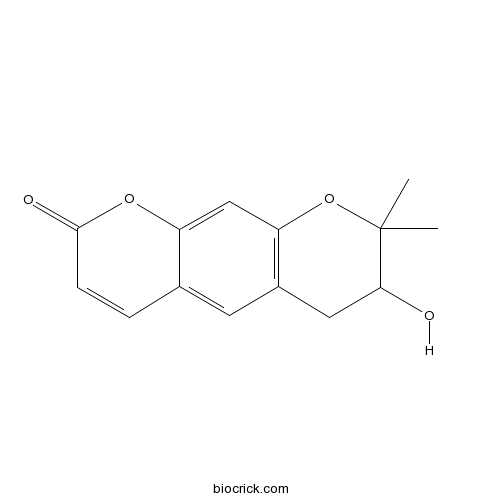3',4'-dihydro-3'-hydroxy-XanthyletinCAS# 5993-18-0 |

- Decursinol
Catalog No.:BCN2638
CAS No.:23458-02-8
Quality Control & MSDS
3D structure
Package In Stock
Number of papers citing our products

| Cas No. | 5993-18-0 | SDF | Download SDF |
| PubChem ID | 600671 | Appearance | Powder |
| Formula | C14H14O4 | M.Wt | 246.3 |
| Type of Compound | Coumarins | Storage | Desiccate at -20°C |
| Solubility | Soluble in Chloroform,Dichloromethane,Ethyl Acetate,DMSO,Acetone,etc. | ||
| Chemical Name | 3-hydroxy-2,2-dimethyl-3,4-dihydropyrano[3,2-g]chromen-8-one | ||
| SMILES | CC1(C(CC2=C(O1)C=C3C(=C2)C=CC(=O)O3)O)C | ||
| Standard InChIKey | BGXFQDFSVDZUIW-UHFFFAOYSA-N | ||
| General tips | For obtaining a higher solubility , please warm the tube at 37 ℃ and shake it in the ultrasonic bath for a while.Stock solution can be stored below -20℃ for several months. We recommend that you prepare and use the solution on the same day. However, if the test schedule requires, the stock solutions can be prepared in advance, and the stock solution must be sealed and stored below -20℃. In general, the stock solution can be kept for several months. Before use, we recommend that you leave the vial at room temperature for at least an hour before opening it. |
||
| About Packaging | 1. The packaging of the product may be reversed during transportation, cause the high purity compounds to adhere to the neck or cap of the vial.Take the vail out of its packaging and shake gently until the compounds fall to the bottom of the vial. 2. For liquid products, please centrifuge at 500xg to gather the liquid to the bottom of the vial. 3. Try to avoid loss or contamination during the experiment. |
||
| Shipping Condition | Packaging according to customer requirements(5mg, 10mg, 20mg and more). Ship via FedEx, DHL, UPS, EMS or other couriers with RT, or blue ice upon request. | ||
| Targets | Antifection |

3',4'-dihydro-3'-hydroxy-Xanthyletin Dilution Calculator

3',4'-dihydro-3'-hydroxy-Xanthyletin Molarity Calculator
| 1 mg | 5 mg | 10 mg | 20 mg | 25 mg | |
| 1 mM | 4.0601 mL | 20.3004 mL | 40.6009 mL | 81.2018 mL | 101.5022 mL |
| 5 mM | 0.812 mL | 4.0601 mL | 8.1202 mL | 16.2404 mL | 20.3004 mL |
| 10 mM | 0.406 mL | 2.03 mL | 4.0601 mL | 8.1202 mL | 10.1502 mL |
| 50 mM | 0.0812 mL | 0.406 mL | 0.812 mL | 1.624 mL | 2.03 mL |
| 100 mM | 0.0406 mL | 0.203 mL | 0.406 mL | 0.812 mL | 1.015 mL |
| * Note: If you are in the process of experiment, it's necessary to make the dilution ratios of the samples. The dilution data above is only for reference. Normally, it's can get a better solubility within lower of Concentrations. | |||||

Calcutta University

University of Minnesota

University of Maryland School of Medicine

University of Illinois at Chicago

The Ohio State University

University of Zurich

Harvard University

Colorado State University

Auburn University

Yale University

Worcester Polytechnic Institute

Washington State University

Stanford University

University of Leipzig

Universidade da Beira Interior

The Institute of Cancer Research

Heidelberg University

University of Amsterdam

University of Auckland

TsingHua University

The University of Michigan

Miami University

DRURY University

Jilin University

Fudan University

Wuhan University

Sun Yat-sen University

Universite de Paris

Deemed University

Auckland University

The University of Tokyo

Korea University
- Vicriviroc maleate
Catalog No.:BCC2038
CAS No.:599179-03-0
- Vindesine sulfate
Catalog No.:BCC8266
CAS No.:59917-39-4
- HPI 1
Catalog No.:BCC3938
CAS No.:599150-20-6
- Vicenin -3
Catalog No.:BCN3014
CAS No.:59914-91-9
- 3-Hydroxy-8,9-methylenedioxypterocarpene
Catalog No.:BCN1407
CAS No.:59901-98-3
- Sulfasalazine
Catalog No.:BCC2545
CAS No.:599-79-1
- 3,3'-Sulfonyldianiline
Catalog No.:BCC8595
CAS No.:599-61-1
- Medicagenic acid
Catalog No.:BCN3893
CAS No.:599-07-5
- Mesopsin
Catalog No.:BCN8050
CAS No.:5989-16-2
- Loliolid
Catalog No.:BCN3655
CAS No.:5989-02-6
- 7-hydroxy-4-benzopyrone
Catalog No.:BCC9209
CAS No.:59887-89-7
- ent-7alpha,9-Dihydroxy-15-oxokaur-16-en-19,6bet-olide
Catalog No.:BCN7401
CAS No.:59885-89-1
- Malotilate
Catalog No.:BCC1196
CAS No.:59937-28-9
- Carlinoside
Catalog No.:BCN2853
CAS No.:59952-97-5
- Tagitinin F
Catalog No.:BCN4101
CAS No.:59979-57-6
- Tagitinin A
Catalog No.:BCN4102
CAS No.:59979-61-2
- EDTA
Catalog No.:BCC7493
CAS No.:60-00-4
- Guanethidine Sulfate
Catalog No.:BCC3789
CAS No.:60-02-6
- H-Tyr-OH
Catalog No.:BCC3123
CAS No.:60-18-4
- Acetylcholine chloride
Catalog No.:BCN2197
CAS No.:60-31-1
- (6-)ε-Aminocaproic acid
Catalog No.:BCC4888
CAS No.:60-32-2
- Linoleic acid
Catalog No.:BCN3821
CAS No.:60-33-3
- Acetamide
Catalog No.:BCN4114
CAS No.:60-35-5
- Acetyl-Strophanthidin
Catalog No.:BCC8113
CAS No.:60-38-8
Isolation of pyranocoumarins from Angelica gigas.
Natural Product Communications, 2008 , 3 (5) :785-790.
A mixture of diastereomers of the coumarin glycoside 3′-O-a-D- glucopyranosyl-3′,4′-dihydroxanthyletin (1), along with six known pyranocoumarins, columbianoside (4), marmesin (5), 3′-hydroxy-3′, 4′-dihydroxanthyletin (3',4'-dihydro-3'-hydroxy-Xanthyletin,6), decursin (7), decursinol angelate (8), and isoimperatorin (9), were isolated from the roots of Angelica gigas Nakai. The racemic compound 1 was successfully separated by preparative HPLC to obtain a new isomer 3′(S)-O-β-D-glucopyranosyl-3′,4′- dihydroxanthyletin (2), and a known isomer 3′(R)-O-β-D- glucopyranosyl-3′,4′-dihydroxanthyletin (3). The absolute configuration of compounds 2 and 3 was determined by comparison of optical rotation and NMR data of their acid hydrolysis products.


